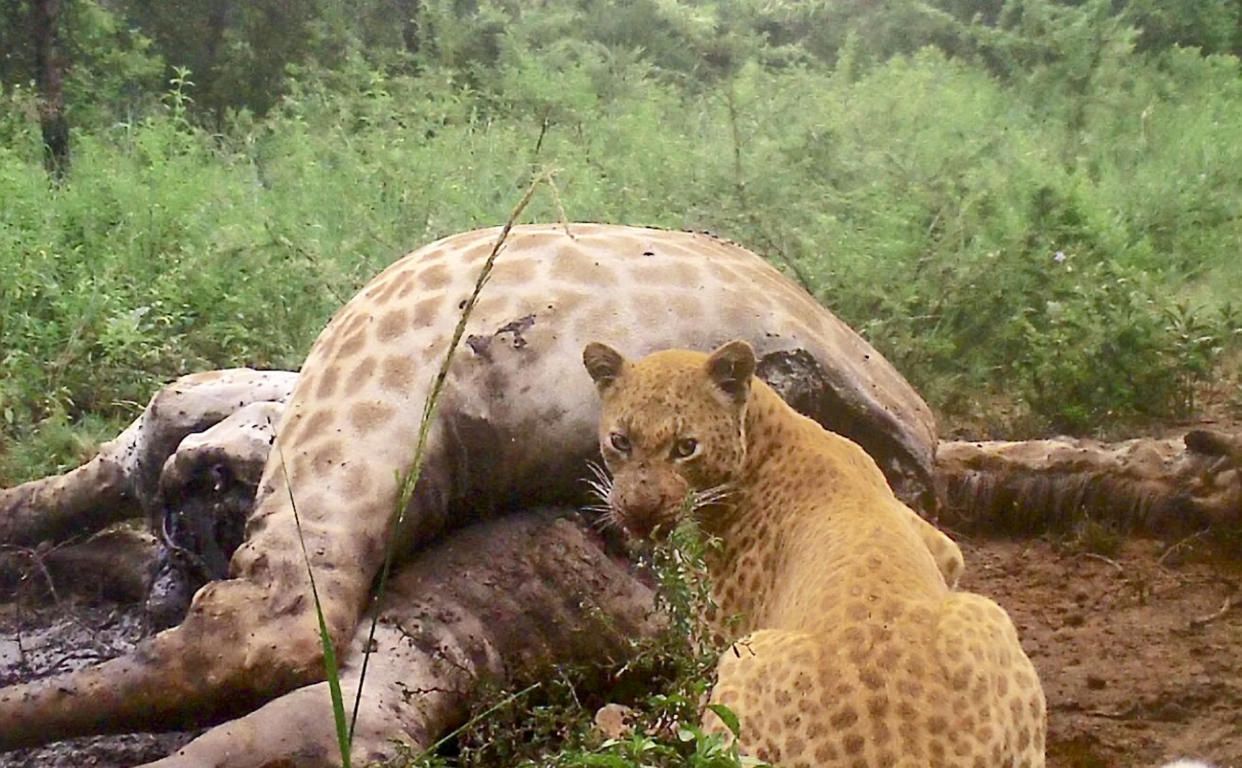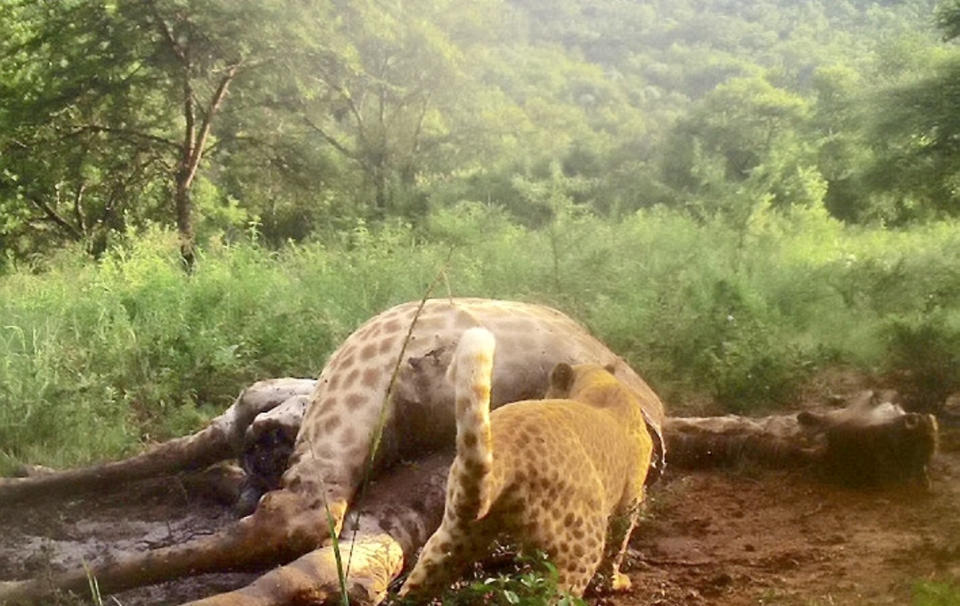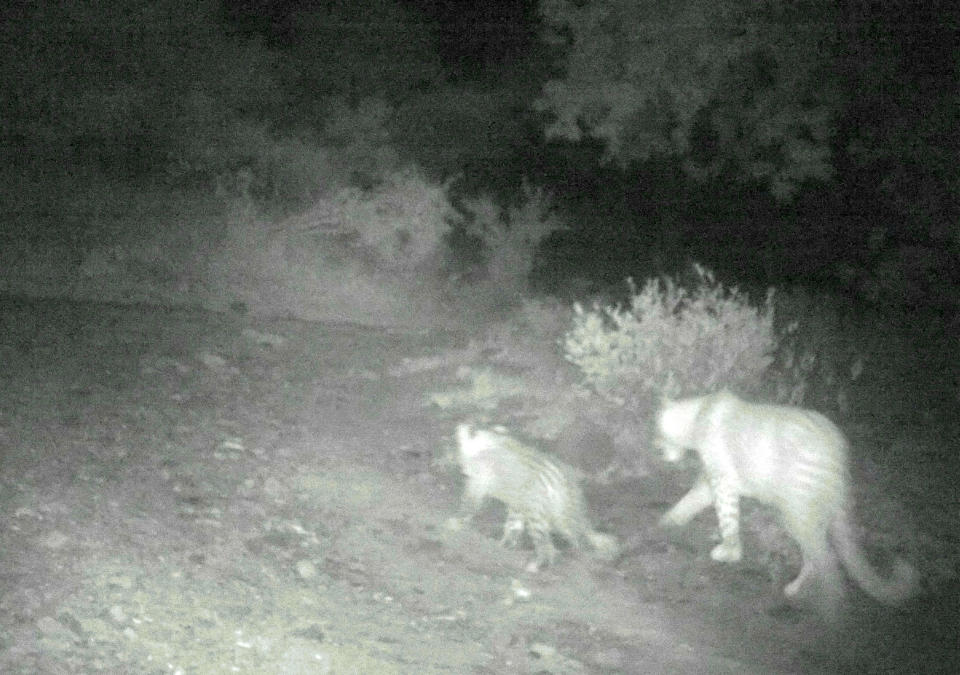Incredible images of rare strawberry leopard captured by couple at wildlife reserve

A very rare leopard has been captured for the first time up close feeding on a dead giraffe in stunning images caught at a reserve in South Africa.
The strawberry leopard - an erythristic species referring to an unusual reddish skin pigmentation - was snapped by a motion triggered camera in Thaba Tholo Wilderness Reserve.
Alan Watson, 45, and his wife Lynsey, 41, had seen the elusive pink hued species skulking around the reserve, but had never been able to catch it on film.
Images show the stunning creature feasting on the carcass near the lodge after the couple set up a camera by pinning it to a tree next to the dead animal, which was killed during an intense thunderstorm.


The pair said they were astonished when a researcher reviewing the pics spotted the strawberry leopard.
Mr Watson, owner of Black Leopard Mountain Lodge, has nicknamed the leopard 'Goldie' and said he's hopeful more of the rare species will be born in years to come.
The big cat - also called the Golden Leopard - was only officially discovered for the first time in 2012, in a different location, close to the Botswana border.
"As far as I know, this is the rarest colour of leopard in the world,” he said.
"A lot of people who come to spot wildlife in the area go away disappointed not to have seen a leopard.

"They are so well camouflaged and incredibly elusive. Even these ones, if they were going through the long grass you wouldn't see them.
"If she doesn't want to be seen, you aren't going to see her.”
Mr Watson, from Belfast in Ireland, started a research programme at his 6,000ha reserve around ten years ago, studying how mostly black leopards survive outside of protected areas.
The area is perfect for wildlife because the mountainous terrain puts off poachers and animal farmers, while the surrounding citrus groves provide perfect safe corridors.
READ MORE FROM YAHOO
Boo, the famously cute dog, has died 'of a broken heart'
Cute or creepy: why humans love some species, loathe others
Meet Kiera, the world’s first Li-Liger
Four years ago Alan caught Goldie - then a cub - on camera with her mum Pippa, but kept quiet, fearing the might not survive into adolescence.
He said locals started talking about an oddly coloured 'lioness' in the area - not home to any lions - and Alan wondered if it might be the now-adult strawberry leopard.
Returning home during a thunder storm in late July, he came across a dead pregnant giraffe, suspected to have died from a heart attack.

After checking there was nothing they could do, they cut her open to encourage predators who would usually be too small to feast on giraffes.
They set up a motion camera, nailed to a tree.
A month later they went to change the batteries, swap the SD card, and look at the photos.
"There she was, this golden leopard feeding from 7am to 9am. It was pretty cool,” Mr Watson said.
"In one, she has turned around and snarled at the camera. You can see her nose wrinkled up. It's quite amazing.

Strawberry leopards are caused by a rare gene mutation called erythrism, a little-understood genetic condition which cause an overproduction of red pigments or an underproduction of dark pigments.
The first one was spotted in the wild and photographed in 2012 in South Africa's Madikwe Game Reserve, more than 500km from the recent sighting.
The amazing photos of her feasting on the giraffe were taken in late July.
He said there have been sightings on his reserve of a second one - not yet caught on camera.
"Our two could be the only two living ones in the wild today," said Mr Watson.
"Obviously I'm hoping there are more."


